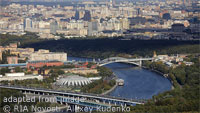Architectural Preservation’s Politics

(Moscow Times – themoscowtimes.com – Delphine d’Amora – July 9, 2013) The battle over the preservation of Moscow’s architectural heritage has become visibly political in recent weeks, as prominent opposition parties criticized acting mayor Sergei Sobyanin’s policies. Several candidates have promised to address the issue in the run-up to this September’s mayoral race.
The primary catalyst in the debate has been the highly-publicized construction on the Bolkonsky House at Vozdvizhenka 9. The classic building, famously described in Tolstoy’s “War and Peace,” has been under scaffold since March, when the Center for Interpersonal Relations set about raising the structure an additional two stories.
Architectural watchdog group “Arkhnadzor” has waged an unmitigated campaign against the project, watching the house day and night, picketing on several occasions, arranging open letters to Sobyanin and President Vladimir Putin, and communicating with mass media.
In a press conference last week, city Duma deputies from the Communist Party denounced the situation and the city government’s lack of response. “It is an aggression against our culture, against our history,” asserted deputy Vladimir Svyatoshenko. His colleague Vladimir Rodin concluded that the situation required a “political response.”
The Department of Cultural Heritage, the government agency responsible for preserving Moscow’s historic landmarks, insists that the issue has been grossly misunderstood by politicians and the press. Department head Aleksandr Kibovsky called the situation a “very difficult legal problem” in an interview with radio station Echo of Moscow last week.
“[The owner] is completely protected by a network of legislation, which in this case guarantees him rights as the owner of this object,” Kibovsky said. He added that, if the building were still a protected monument, “it would be a completely different conversation.” It was removed from the list in 2009.
The Bolkonsky House is still located in one of Moscow’s more than 200 “integrated protected zones.” In these areas, it is illegal to build new structures or alter the historic image of existing ones.
Tensions escalated further in the city Duma two weeks ago, when Sobyanin proposed an amendment to legislation which would eliminate the requirement that all construction projects in protected zones receive the approval of the Department of Cultural Heritage.
Opposition parties have challenged the proposal. Sergei Mitrokhin, the Yabloko party’s candidate for mayor of Moscow, told Kommersant that the amendment was made “in the interests of developers” and that Yabloko “would definitely include (this issue) in its election platform.” The Republican Party of Moscow announced that their own candidate, notorious opposition blogger and activist Aleksei Navalny, who has been standing trial, will also address the issue.
According to the Department of Cultural Heritage, the amendment is a simple technical matter intended to reconcile city and federal legislation. They have emphasized that it does not concern the historic monuments, but only the protected zones surrounding them.
Kibovsky has expressed disappointment in the media and activists for dwelling on this point while largely ignoring a new law that will be put into affect on August 7. The “revolutionary for the preservation movement,” law will raise the potential fines for damaging a monument up to 60 million rubles and give his department the right to perform investigations on violators.
Arkhnadzor coordinator Konstantin Mikhailov insisted that the protected zone legislation was a significant tool in favor of preservation and in no way contradicted federal law, which mandates that these zones be controlled without defining the procedures for doing so.
“They are trying to legalize the current situation,” Mikhailov said. “The Department of Cultural Heritage does not receive these projects, does not approve them, does not look after the condition of protected zones … There is no necessity to get rid of [the law], on the contrary, we need to make it work and make government agencies abide by it.”
The proposed amendments have been tabled until after the elections, but they still managed to prompt vocal comparisons between Sobyanin and his infamously developer-friendly predecessor, Yury Luzhkov.
Editors of the independent business daily Vedomosti recently published an editorial entitled “Sergei Sobyanin as Yury Luzhkov,” in which they recalled the heavy architectural losses Moscow suffered under its previous mayor (470 historic buildings lost, more than 90 of them recognized monuments).”There is a risk,” they warned, “that the old barbarism will be replaced by a new one.”
When Sobyanin took over from Luzhkov in 2011, he immediately declared a moratorium on all construction in the city center, bringing over 200 projects to a breaking halt pending review. Some activists began referring to “Sobyanin’s urban planning revolution.”
Two years later, with the Bolkonsky House in the news and several historic buildings already lost to developers, the optimism has somewhat waned. Nonetheless, those involved in preservation agree that the situation has improved.
Irina Korobina, Director of the Shchusev State Museum of Architecture, remembers the cultural protection apparatus under Luzhkov as “a kind of business.” “They sold various permits for money. And the majority of the people who worked in the agencies for the preservation of heritage, they had their own constructions firms,” she said.
“The Department of Cultural Heritage under the direction of Aleksandr Kirbovsky has, it seems to me, done a colossal job,” she continued. In two years, the agency has instituted new regulations for the protection of Moscow’s center, begun prosecuting legal infractions, and made previously obscure procedures more transparent.
Mikhailov agrees that the sheer number of historic buildings lost has decreased. But he sees a negative trend too: The individual losses tend to be more significant. “Before, we didn’t sacrifice buildings like the Bolkonsky House and the Circular Depot,” he said.
